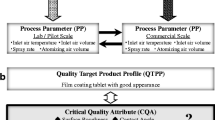Abstract
The purpose of this paper is to find the optimum conditions of the film coating process for polymer blends and the influence of major processing parameters on the morphological properties of the material surface has been discussed. The surface roughness is regarded as the target characteristic of the smaller-the-better system. In order to achieve the aim of the multiple-response process of robustness, the grey-based Taguchi method is proposed. Nine experimental trials based on the L9(34) orthogonal array are conducted to determine the optimum processing conditions, the significant factor levels, and the percent contributions together with the analysis of variance (ANOVA). Also, confirmation experiments are performed to verify that the experimental results are reproducible. Moreover, atomic force microscopy (AFM) can be carried out with 3D atomic resolution in air for the measurement and analysis of the precision surface .
Similar content being viewed by others
References
Thuenemann AF (2000) Nano-structure materials with low surface energies formed by polyelectrolytes and fluorinated amphiphiles (PEFA). Polym Int 49(7):636–644
Wong CP, Rao Y, Yue J (2002) Material characterization of high dielectric constant polymer-ceramic composite for embedded capacitor to RF application. Active Passive Electron Compon 25(1):123–129
Zhang J, Wilkie CA (2003) Preparation and flammability properties of polyethylene-clay nanocomposites. Polym Degradation Stab 80(1):163–169
Hansma PK, Elings VB, Marti O, Bracker CE (1988) Scanning tunneling microscopy and atomic force microscopy: application to biology and technology. Science 242:209–216
Hansma PK, Cleveland JP, Radmacher M, Walters DA, Hillner PE, Bezanilla M, Fritz M, Vie D, Hansma HG (1994) Tapping mode atomic force microscopy in liquids. Appl Phys Lett 64(13):1738–1740
Karbach A, Drechsler D (1999) Atomic force microscopy – a powerful tool for industrial applications. Surf Interf Anal 27(5-6):401–409
Roy RK (1990) A primer on the Taguchi method. Van Nostrand, New York.
Tarng YS, Juang SC, Chang CH (2002) The use of grey-based Taguchi methods to determine submerged arc welding process parameters in hardfacing. J Mater Proc Technol 128(1-3):1–6
Lin ZC, Ho CY (2003) Analysis and application of grey relation and ANOVA in chemical-mechanical polishing process parameters. Int J Adv Manuf Technol 21(1):10–14
Huang JT, Liao YS (2003) Optimization of machining parameters of Wire-EDM based on Grey relational and statistical analyses. Int J Prod Res 41(8):1707–1720
Author information
Authors and Affiliations
Corresponding author
Rights and permissions
About this article
Cite this article
Kuo, CF., Wu, YS. Optimization of the film coating process for polymer blends by the grey-based Taguchi method. Int J Adv Manuf Technol 27, 525–530 (2006). https://doi.org/10.1007/s00170-004-2217-1
Received:
Accepted:
Published:
Issue Date:
DOI: https://doi.org/10.1007/s00170-004-2217-1




